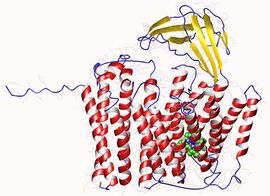Biology:Holocytochrome-c synthase
| holocytochrome-c synthase | |||||||||
|---|---|---|---|---|---|---|---|---|---|
 Holocytochrome-c synthase monomer, Thermus thermophilus | |||||||||
| Identifiers | |||||||||
| EC number | 4.4.1.17 | ||||||||
| CAS number | 75139-03-6 | ||||||||
| Databases | |||||||||
| IntEnz | IntEnz view | ||||||||
| BRENDA | BRENDA entry | ||||||||
| ExPASy | NiceZyme view | ||||||||
| KEGG | KEGG entry | ||||||||
| MetaCyc | metabolic pathway | ||||||||
| PRIAM | profile | ||||||||
| PDB structures | RCSB PDB PDBe PDBsum | ||||||||
| Gene Ontology | AmiGO / QuickGO | ||||||||
| |||||||||
| Cytochrome c/c1 heme lyase | |||||||||
|---|---|---|---|---|---|---|---|---|---|
| Identifiers | |||||||||
| Symbol | Cyto_heme_lyase | ||||||||
| Pfam | PF01265 | ||||||||
| InterPro | IPR000511 | ||||||||
| PROSITE | PDOC00647 | ||||||||
| |||||||||
The enzyme holocytochrome-c synthase (EC 4.4.1.17) catalyzes the chemical reaction
- holocytochrome c [math]\displaystyle{ \rightleftharpoons }[/math] apocytochrome c + heme
This enzyme belongs to the family of lyases, specifically the class of carbon-sulfur lyases. The systematic name of this enzyme class is holocytochrome-c apocytochrome-c-lyase (heme-forming). Other names in common use include cytochrome c heme-lyase, holocytochrome c synthetase, and holocytochrome-c apocytochrome-c-lyase. This enzyme participates in porphyrin and chlorophyll metabolism.
Cytochrome c heme-lyase (CCHL) and cytochrome Cc1 heme-lyase (CC1HL) are mitochondrial enzymes that catalyze the covalent attachment of a heme group on two cysteine residues of cytochrome c and c1. These two enzymes are functionally and evolutionary related. There are two conserved regions, the first is located in the central section and the second in the C-terminal section. Both patterns contain conserved histidine, tryptophan and acidic residues which could be important for the interaction of the enzymes with the apoproteins and/or the heme group.[1]
The human enzyme, HCCS, processes both cytochromes c and c1.[2]
References
- ↑ "Molecular cloning and characterization of the Saccharomyces cerevisiae CYT2 gene encoding cytochrome-c1-heme lyase". Eur. J. Biochem. 207 (3): 1093–100. August 1992. doi:10.1111/j.1432-1033.1992.tb17146.x. PMID 1499554.
- ↑ "Overlapping specificities of the mitochondrial cytochrome c and c1 heme lyases". The Journal of Biological Chemistry 278 (50): 49732–42. December 2003. doi:10.1074/jbc.M308881200. PMID 14514677.
- "Identification and sequence of the gene encoding cytochrome c heme lyase in the yeast Saccharomyces cerevisiae". EMBO J. 6 (1): 235–41. 1987. doi:10.1002/j.1460-2075.1987.tb04744.x. PMID 3034577.
 |

